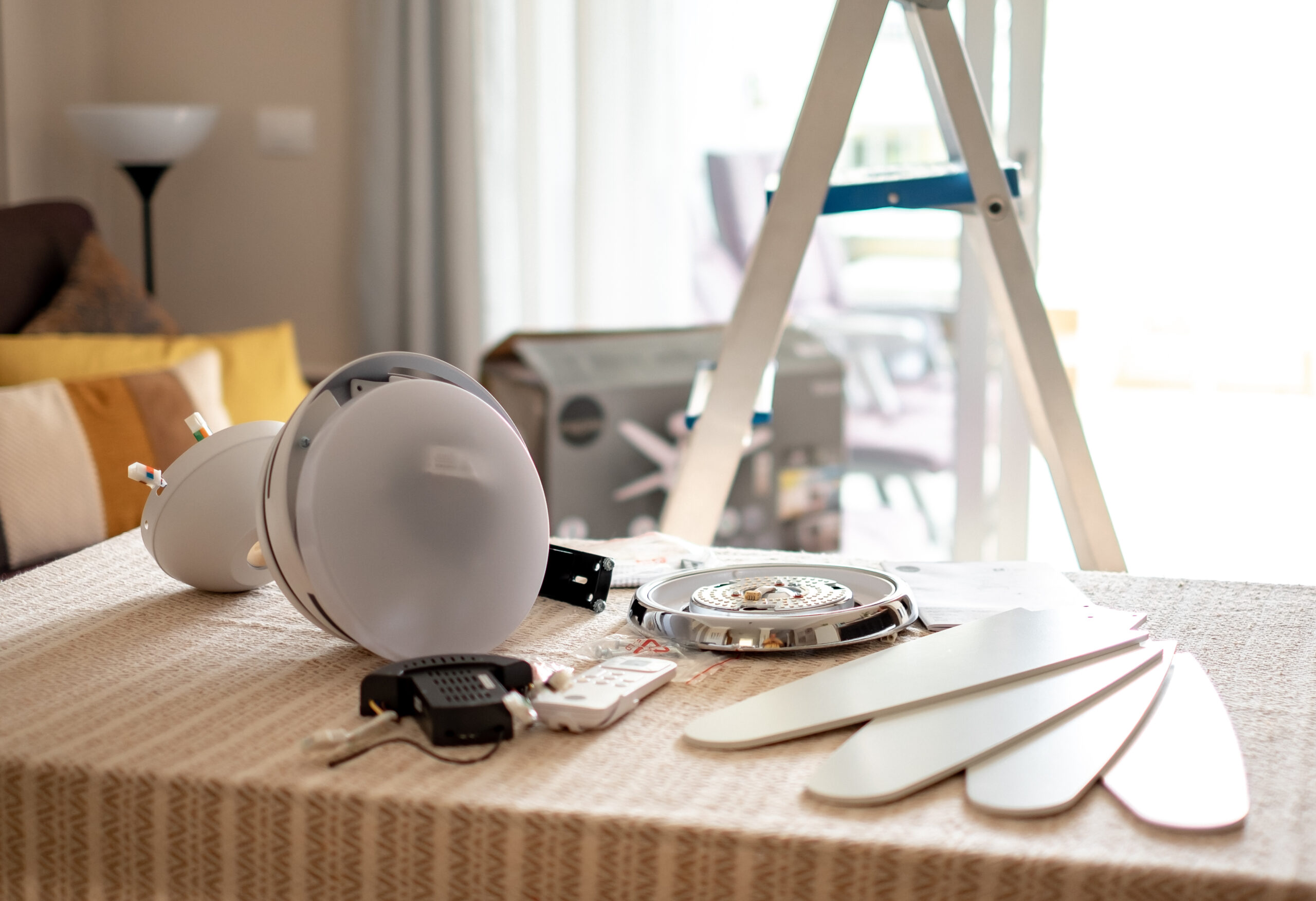You’ve probably pondered the idea of adding or replacing a ceiling fan in your home, wondering about the best approach to ensure it enhances your comfort and complements your decor.
Ceiling fans are not just functional; they can also be a stylish addition to any room, providing energy-efficient cooling and improving air circulation.
But how do you go about installing one correctly to avoid common pitfalls and ensure optimal performance?
In this article, we’ll delve into the intricacies of Ceiling Fan Installation, providing you with a comprehensive guide to ensure your new fan not only looks great but functions flawlessly.
We’ll cover everything from selecting the right fan for your space to the final touches of installation, ensuring you have all the knowledge needed to make this a successful home improvement project.
Also read: Urgent Solutions: Mastering Emergency Electrical Repairs

What is Ceiling Fan Installation?
Ceiling Fan Installation is a meticulous process that transforms your living space by enhancing air circulation and adding a touch of style.
When you decide to install a ceiling fan, you’re not just adding a functional appliance; you’re incorporating a feature that can alter the ambiance and comfort level of your room. This process involves several key steps, each crucial to ensuring the fan functions efficiently and safely.
The journey of installing a ceiling fan begins with the selection of the right fan. It’s essential to consider the size of the room, the height of the ceiling, and the fan’s design to ensure it complements your space and meets your needs.
Once you’ve chosen the perfect fan, the next step is the installation process, which starts with the electrical wiring. This step is vital as it connects the fan to your home’s power supply, enabling it to operate.
Securing the fan in place is the next critical step. This involves attaching the fan securely to the ceiling to ensure it remains stable and safe during operation.
The mounting process must be done with precision to prevent any wobbling or shaking, which could lead to noise or, worse, a safety hazard.
After the fan is securely mounted, the final step is to ensure it operates correctly and safely. This includes checking the electrical connections, testing the fan’s operation, and ensuring there are no loose parts that could cause problems down the line.
Proper installation ensures that the fan will provide optimal air circulation, improving the comfort of your living space and potentially reducing energy costs by allowing for more efficient heating and cooling.
Ceiling Fan Installation is more than just a mechanical task; it’s an investment in your home’s comfort and efficiency.
By understanding and following the correct installation process, you can enjoy the benefits of a well-installed ceiling fan that enhances your living environment and provides year-round comfort.
How to Choose the Right Ceiling Fan
Understanding Room Size and Ceiling Height
The initial phase of Ceiling Fan Installation is crucial: selecting the ideal fan that aligns with the dimensions and style of your room.
The size of the room dictates the fan’s blade span, ensuring efficient air circulation without overwhelming the space. For smaller rooms, a fan with a smaller diameter is suitable, whereas larger spaces require fans with a broader blade span to effectively circulate air.
Ceiling height also plays a pivotal role in your selection process.
Standard installations are ideal for ceilings about 8 feet high, but if your ceilings are higher, you’ll need a down rod to ensure the fan is positioned optimally for effective air movement. For lower ceilings, a flush-mount design might be necessary to maintain adequate clearance and safety.
Style and Features Matter
Beyond functionality, the fan’s style should complement your room’s aesthetic.
Ceiling fans come in a myriad of designs, from modern to rustic, and with various features like lighting, remote controls, and energy-efficient motors. Selecting a fan that matches your decor enhances your room’s ambiance while providing practical benefits.
Efficiency and Performance
When choosing a fan, consider its efficiency and performance.
Look for fans with energy-efficient motors and those that offer multiple speed settings to customize airflow and maximize comfort. The fan’s performance is not just about air movement; it’s also about how it fits into your lifestyle, offering convenience and efficiency.
By carefully selecting the right ceiling fan, and considering the size, style, efficiency, and features, you set the stage for a successful installation.
This ensures not only enhanced comfort and style in your room but also an efficient, energy-saving addition to your home.

Preparing for Installation
Gathering Tools and Materials
Before diving into the Ceiling Fan Installation process, it’s essential to prepare by gathering all the necessary tools and materials.
You’ll need a variety of tools, including a ladder, screwdrivers, wire strippers, a circuit tester, and possibly a drill. Having everything on hand before you start will streamline the installation process and reduce the need for unnecessary interruptions.
Ensuring Safety First
Safety is paramount when it comes to Ceiling Fan Installation. The first step is to turn off the power at the circuit breaker to eliminate any risk of electrical shock.
Using a circuit tester, confirm that the power is indeed off in the area where you’ll be working. This precaution is crucial, whether you’re installing a new fan or replacing an existing one.
Removing Existing Fixtures
If you’re replacing an existing fan or light fixture, you’ll need to remove it carefully. Follow the manufacturer’s instructions to detach the fixture safely and correctly.
This step often involves unscrewing the fixture from the mounting bracket and disconnecting the wiring. Be sure to support the weight of the fixture as you disconnect it to prevent any damage or injury.
Understanding Wiring and Electrical Connections
Familiarize yourself with the wiring in your ceiling.
You’ll typically encounter three wires: a hot wire (usually black), a neutral wire (white), and a ground wire (green or bare copper). Understanding the function of each wire is crucial for a safe and successful installation.
If you’re not confident in your ability to handle electrical connections, consider consulting with or hiring a professional electrician.
By preparing for the installation, ensuring you have the right tools, prioritizing safety, and understanding the steps involved in removing existing fixtures and handling electrical connections, you set a solid foundation for a smooth and successful Ceiling Fan Installation.
Also read: Revitalize Your Home: Mastering Electrical Repairs for Safety & Efficiency
Mounting the Fan Bracket
Securing the Foundation
The fan bracket serves as the critical foundation for your Ceiling Fan Installation. It’s imperative to securely attach this bracket to the ceiling box, as it will bear the entire weight of the ceiling fan.
Start by aligning the bracket with the mounting holes in the ceiling box.
Use the provided screws to firmly attach the bracket, ensuring there is no play or wobble. This step is vital for the long-term safety and stability of your ceiling fan.
Checking the Ceiling Box
Before proceeding, it’s essential to verify that the ceiling box is rated to support a ceiling fan.
Not all ceiling boxes are suitable for fan installation; some are only designed to hold light fixtures. If you’re uncertain, it’s worth replacing the existing box with one specifically rated for ceiling fan support.
This precaution prevents potential hazards and ensures the fan remains securely mounted.
Aligning the Bracket
Proper alignment of the fan bracket is crucial for a balanced installation. Ensure that the bracket is level and aligned correctly with the ceiling box.
Any misalignment can lead to issues with the fan’s balance and operation down the line. Use a level to check the bracket’s position before finalizing the installation.
Preparing for Wiring
The fan bracket often includes a hook or a slot to hang the fan motor while you connect the wiring. This feature is incredibly helpful, as it allows you to work on the electrical connections without needing to hold the fan’s weight.
Ensure you understand how to utilize this aspect of the bracket to facilitate a smoother installation process.
By securing and aligning the fan bracket, you lay a solid foundation for the rest of the Ceiling Fan Installation process. This step is crucial for the fan’s safety, performance, and longevity, ensuring it remains stable and functional for years to come.
Assembling and Hanging the Fan
Step-by-Step Fan Assembly
The assembly of your ceiling fan is a pivotal step in the Ceiling Fan Installation process. Begin by laying out all the parts and reviewing the manufacturer’s instructions carefully.
Typically, you’ll start by attaching the fan blades to the motor or the blade irons. It’s crucial to ensure that these are securely fastened to prevent any wobble or noise when the fan is in operation.
Pay close attention to the screws and fittings provided, as using the correct ones is essential for a secure assembly.
Attaching the Fan to the Bracket
Once the fan is assembled, the next step is to hang it on the bracket you’ve securely mounted to the ceiling box.
Most ceiling fans come with a hanging mechanism that allows the fan to be suspended from the bracket while you connect the wiring, making this step a bit easier to manage.
Ensure that the fan is properly seated in the bracket and that any locking mechanisms are engaged to prevent the fan from falling.
Wiring the Fan
Wiring is a critical component of Ceiling Fan Installation. Follow the wiring diagram provided by the manufacturer to connect the fan’s wires to your home’s electrical system.
Typically, this involves matching the fan’s wires to the corresponding wires in the ceiling: black to black (hot), white to white (neutral), and green or bare copper to green or bare copper (ground).
Use wire nuts to secure the connections and electrical tape to ensure they are insulated and won’t come loose over time.
Securing and Testing the Fan
After the wiring is connected, secure the fan to the bracket according to the manufacturer’s instructions. This often involves tightening screws to ensure the fan is firmly attached to the bracket.
Once the fan is secured, it’s time for a crucial step: testing. Restore power to the circuit and turn on the fan to ensure it operates smoothly.
Check for any unusual noises, wobble, or other issues that might indicate a problem with the installation.
By assembling and hanging your ceiling fan, and following the manufacturer’s instructions for wiring and securing the fan, you can ensure a successful Ceiling Fan Installation.
This attention to detail will result in a safely installed, efficient, and reliable ceiling fan that enhances the comfort and style of your space.

Final Touches in Ceiling Fan Installation
Adding Light Fixtures and Accessories
After the ceiling fan is securely mounted and wired, it’s time to focus on the final touches that can enhance both its functionality and aesthetic appeal.
If your ceiling fan comes with light fixtures, carefully attach them according to the manufacturer’s instructions.
Ensure that all light bulbs are the correct type and wattage for your fan’s specifications to prevent overheating or electrical issues.
For fans with additional accessories, such as remote controls or pull chains, ensure these are attached and functioning correctly. These elements not only contribute to the fan’s operation but also its overall look and feel in your room.
Testing the Fan’s Operation
With everything in place, restore power to the circuit and test the fan. Turn it on using the wall switch, remote control, or pull chain, and observe its operation at various speeds.
The fan should operate smoothly and quietly without any signs of wobbling or strange noises. Testing each feature, including the light fixtures and any speed settings, is crucial to confirm that everything is working as it should.
Balancing the Fan
Even with careful installation, some ceiling fans may exhibit wobbling, which can be due to slight variations in blade weight or alignment.
Most ceiling fans come with a balancing kit, which you can use to make adjustments and stabilize the fan. Follow the kit’s instructions to adjust the weight on the fan blades until the fan operates without wobbling. This step is essential for both the fan’s performance and the safety of your living space.
Ensuring Quiet Operation
A well-installed ceiling fan should operate quietly. If you notice any unusual sounds, such as clicking, humming, or rattling, it may indicate loose components or issues with the installation.
Double-check that all screws are tightened and that there’s no contact between moving parts and stationary parts of the fan.
By adding the final touches, testing the fan’s operation, and ensuring proper balance and quiet operation, you can conclude the Ceiling Fan Installation process with confidence.
These steps are crucial for achieving a functional, aesthetically pleasing, and safe ceiling fan installation that enhances your home’s comfort and style.
Maintenance Tips for Your Ceiling Fan
Maintaining your ceiling fan is crucial for ensuring its longevity and efficiency.
Regular upkeep not only enhances the fan’s performance but also contributes to its durability. Here are some essential maintenance tips to keep your ceiling fan in pristine condition.
Regular Dusting
Dust accumulation on fan blades can significantly impact the fan’s efficiency and balance.
Over time, dust can build up, leading to reduced airflow and potential strain on the motor.
Use a soft cloth or a specialized duster to gently clean the blades at least once a month. For fans mounted at a higher ceiling, using an extendable duster can make the job easier and safer, eliminating the need for a ladder.
Tightening Loose Components
A wobbling fan is often a sign of loose screws in the fan blades or mounting brackets.
Regularly check these components and tighten any loose screws. This not only reduces the annoying wobble but also prevents potential damage to the fan or ceiling due to the extra vibration and movement.
Lubricating the Motor
Not all, but some ceiling fans require periodic lubrication to keep the motor running smoothly. Consult your fan’s manual to determine if lubrication is necessary and the recommended type of oil.
Typically, applying a few drops of oil to the motor annually can prevent grinding or squeaking noises and prolong the motor’s lifespan.
Inspecting and Adjusting Fan Blades
Fan blades can become bent or warped over time, affecting the fan’s balance and performance.
Periodically inspect the blades for any signs of wear or distortion. If you notice any issues, you may need to adjust the blade alignment or replace the affected blades to maintain optimal performance and balance.
Adjusting Blade Direction
Most ceiling fans feature a switch that allows you to change the blade rotation direction. In the winter, set the blades to rotate clockwise to help circulate warm air throughout the room.
In the summer, switch the direction counterclockwise to create a cooling breeze. This simple adjustment can enhance your comfort and contribute to energy savings by working in tandem with your heating and cooling systems.
By following these maintenance tips, you can ensure that your ceiling fan continues to operate efficiently, providing comfort and style to your living space for years to come.
Troubleshooting Common Ceiling Fan Issues
Even with diligent maintenance, ceiling fans can sometimes encounter operational issues.
Understanding how to troubleshoot these problems can help you quickly restore your fan’s functionality and performance. Here’s a guide to identifying and resolving some of the most common ceiling fan issues.
Addressing Fan Wobbles
A wobbling ceiling fan is not only annoying but can also indicate a potential safety issue. First, check that all fan blades are securely attached and aligned at the same height.
If the wobble persists, use a balancing kit to adjust the weight distribution on the blades. This kit typically includes weights that you attach to the blades to achieve balance and ensure smooth operation.
Resolving Power Issues
If your ceiling fan doesn’t turn on, first verify that the power is on and the circuit breaker hasn’t tripped.
Next, check the wiring connections in the fan’s canopy to ensure they are secure and properly matched. If your fan is operated by a remote control, it’s also a good idea to check the batteries, as depleted batteries are a common culprit for non-responsive fans.
Eliminating Noisy Operation
A noisy ceiling fan can disrupt the peaceful ambiance of your space. Tighten any loose screws on the fan blades and motor housing to reduce rattling or humming noises.
If the noise persists, it could indicate internal motor issues or blade misalignment. In such cases, realigning the blades or consulting a professional may be necessary.
Fixing Fan Speed Issues
If your fan isn’t reaching its intended speed, the issue might lie with the fan’s capacitor, a component that helps regulate the electrical flow to the motor.
Over time, capacitors can wear out, affecting the fan’s speed settings. Replacing the capacitor is typically a straightforward fix that can restore your fan’s speed functionality.
Troubleshooting Light Fixture Problems
For ceiling fans equipped with light fixtures, issues like flickering or non-functioning lights can arise. Check the light bulbs to ensure they’re functioning and compatible with your fan.
Also, verify that all connections between the light kit and the fan are secure. If the light fixture is detachable, ensure it’s properly attached to the fan.
This guide provides a comprehensive approach to troubleshooting common ceiling fan issues. Understanding these troubleshooting steps can help you maintain your Ceiling Fan Installation in optimal working condition, ensuring it continues to provide comfort and efficiency in your home.
DIY vs. Professional Ceiling Fan Installation
When it comes to Ceiling Fan Installation, homeowners often face the decision of whether to embark on a DIY project or to hire professionals.
Both approaches have their merits and can be suitable depending on your skills, experience, and the complexity of the installation.
DIY Ceiling Fan Installation
Cost-Effective
One of the primary advantages of DIY Ceiling Fan Installation is the potential cost savings. By handling the installation yourself, you can save on labor costs associated with hiring a professional.
Personal Satisfaction
Completing a DIY project can provide a sense of accomplishment and the opportunity to acquire new skills. Successfully installing your ceiling fan can add a personal touch to your home and give you a deeper understanding of how your home’s electrical systems work.
Considerations
However, DIY installation requires a certain level of electrical knowledge and comfort with handling tools and hardware. It’s crucial to ensure you have the right tools, follow the manufacturer’s instructions carefully, and adhere to safety protocols to avoid any potential hazards.
Professional Ceiling Fan Installation
Expertise and Efficiency
Professional electricians, like those at The Local Electrician TX, bring a wealth of experience and expertise to Ceiling Fan Installation. They can handle complex installations, troubleshoot unexpected issues, and ensure that the fan is installed safely and efficiently.
Safety and Reliability
Safety is a paramount concern with any electrical installation. Professionals are trained to manage electrical connections safely and ensure that the ceiling fan is securely mounted, reducing the risk of future complications.
Warranty and Peace of Mind
Many professional installation services come with a warranty, offering peace of mind that any post-installation issues will be addressed. This assurance is something that DIY installations typically lack.
Time-Saving
Hiring a professional can significantly reduce the time it takes to install a ceiling fan. Experts are equipped to handle the installation swiftly, allowing you to enjoy the benefits of your new fan without dedicating a significant amount of time to the project.
The choice between DIY and professional Ceiling Fan Installation depends on your confidence in your DIY skills, the complexity of the installation, and your budget.
While DIY projects can be rewarding and cost-effective, professional installation offers expertise, safety, and time efficiency. Whichever route you choose, ensuring a proper installation is key to enjoying the benefits of your ceiling fan and enhancing the comfort and style of your home.
Enhancing Your Home with Ceiling Fan Installation
Ceiling Fan Installation is not just about improving air circulation; it’s a strategic choice that can elevate the comfort, energy efficiency, and aesthetic appeal of your home.
Beyond the basic steps of installation, understanding the broader benefits and considerations can help you make the most of this home improvement project.
Energy Efficiency and Cost Savings
Installing a ceiling fan can lead to significant energy savings throughout the year.
By facilitating better air circulation, a ceiling fan allows you to adjust your thermostat settings, reducing the reliance on air conditioning in summer and heating in winter.
This adjustment can result in considerable cost savings on your energy bills, making Ceiling Fan Installation an eco-friendly and economically wise choice.
Aesthetic Appeal and Home Value
Ceiling fans come in a variety of styles, designs, and finishes, allowing you to choose a model that complements your home’s decor.
Whether you prefer a modern, sleek design or a classic, ornate fan, the right choice can serve as a focal point in a room, enhancing its overall aesthetic appeal. Furthermore, the addition of a ceiling fan can increase your home’s attractiveness to potential buyers, potentially boosting its market value.
Comfort and Well-Being
The primary function of a ceiling fan is to improve the comfort of your living space.
By providing a gentle breeze, a ceiling fan can make a room feel cooler and more pleasant without the need for air conditioning.
In winter, reversing the fan’s direction can help redistribute warm air that rises to the ceiling, maintaining a comfortable temperature throughout the room. This improved air circulation can also contribute to better indoor air quality, promoting a healthier living environment.
Customization and Control
Modern ceiling fans offer a range of customization options, from adjustable speed settings to integrated lighting and remote control operation.
These features allow you to tailor the fan’s operation to your specific needs and preferences, whether you’re looking to create a gentle breeze, enhance illumination, or control the fan from the comfort of your couch.
By selecting a ceiling fan with these advanced features, you can enjoy greater convenience and control over your home’s environment.
Long-Term Durability and Maintenance
When selecting a ceiling fan for installation, consider the fan’s build quality and durability.
A well-constructed ceiling fan can provide years of reliable service with minimal maintenance. Regular cleaning and occasional checks for loose components can help extend the fan’s lifespan, ensuring that your investment continues to enhance your home’s comfort and style for the long term.
Incorporating Ceiling Fan Installation into your home improvement plans is a decision that offers multiple benefits, from energy savings and aesthetic enhancement to improved comfort and air quality.
By choosing the right fan and considering the broader implications of the installation, you can maximize these benefits, making your home more comfortable, attractive, and energy-efficient.
Strategic Placement and Integration of Ceiling Fans
When considering Ceiling Fan Installation, the strategic placement and integration of the fan within your home’s layout and design can significantly amplify its benefits.
Thoughtful positioning not only maximizes air circulation but also enhances the fan’s contribution to your home’s ambiance and functionality.
Optimizing Airflow with Strategic Placement
The location of your ceiling fan plays a pivotal role in its effectiveness. For optimal air circulation, the fan should be installed in the center of the room, ideally at least 7 feet above the floor and 18 inches from the nearest wall.
In larger rooms, consider installing multiple fans to ensure even air distribution. By strategically positioning fans, you can create a more comfortable and inviting environment in every corner of your space.
Integrating Ceiling Fans into Home Automation
With advancements in home technology, integrating Ceiling Fan Installation into your home automation system can offer enhanced convenience and efficiency.
Smart ceiling fans can be controlled via smartphone apps, voice commands, or integration with other smart home devices, allowing you to adjust settings based on your preferences or even automate fan operation based on time of day or room occupancy.
This seamless integration not only simplifies control but also helps optimize energy usage, adapting the fan’s operation to real-time needs.
Complementing Your Home’s Decor
Beyond functionality, the design of the ceiling fan should harmonize with your home’s interior style.
Ceiling Fan Installation offers an opportunity to accentuate your decor, whether you’re aiming for a statement piece that stands out or a subtle design that blends seamlessly with the room’s aesthetic.
With a wide array of styles, materials, and finishes available, you can select a ceiling fan that complements your home’s design theme, adding both style and comfort to your living spaces.
Incorporating Ceiling Fan Installation into your home not only enhances comfort and energy efficiency but also provides an opportunity to elevate your home’s design and integrate cutting-edge technology.
By considering the placement, automation, and aesthetic aspects of your ceiling fan, you can create a more comfortable, convenient, and stylish environment that aligns with your lifestyle and design preferences.
Tips and Strategies for Efficient Ceiling Fan Installation
Installing a ceiling fan can significantly enhance the comfort and style of your home. However, ensuring the installation process is smooth and efficient requires attention to detail and adherence to best practices.
Here are some essential tips and strategies to help you achieve an efficient installation.
Selecting the Appropriate Fan
Room Size and Ceiling Height: The size of the fan should be proportional to the room to ensure optimal airflow.
A fan that’s too small won’t effectively circulate air in a large room, while a fan that’s too large can overwhelm a small space. Additionally, the height of the ceiling determines whether you need a flush mount, downrod, or angled mount for your fan.
Fan Style: Choose a ceiling fan that complements the interior design of your room. Ceiling fans come in a variety of styles and finishes, so select one that aligns with your decor preferences and enhances the aesthetic appeal of the space.
Utilizing the Correct Tools
Having the right tools at your disposal is crucial for a smooth installation process. Typically, you’ll need a screwdriver, wire stripper, ladder, and a voltage tester.
Ensure you have all these tools on hand before you begin the installation to avoid any interruptions.
Adhering to Manufacturer Instructions
Each ceiling fan model may have specific installation requirements.
Carefully read and follow the manufacturer’s instructions provided with your fan. These instructions are designed to guide you through the installation process safely and effectively, ensuring that the fan is installed correctly and operates as intended.
Seeking Professional Assistance
If you’re not confident in your electrical skills or if the installation process seems overly complex, don’t hesitate to seek professional help.
Hiring a qualified electrician can ensure that your ceiling fan is installed safely and correctly, adhering to all local building codes and regulations. This is especially important if you need to make any modifications to your home’s electrical wiring.
By choosing the right fan, preparing the necessary tools, following the manufacturer’s instructions, and knowing when to seek professional help, you can ensure an efficient and successful Ceiling Fan Installation.
These tips and strategies not only facilitate a smoother installation process but also contribute to the long-term performance and safety of your ceiling fan.
The Local Electrician TX and Ceiling Fan Installation
When it comes to Ceiling Fan Installation in Texas, The Local Electrician TX stands out as a reliable provider of expert installation services.
Their team of skilled electricians ensures that your ceiling fan is installed with precision, adhering to the highest safety and efficiency standards.
Expert Installation Services
Professionalism and Expertise
The Local Electrician TX employs a team of experienced professionals who specialize in ceiling fan installations. Their expertise ensures that your ceiling fan is installed correctly, and functioning optimally to provide maximum comfort and efficiency in your home.
Safety First
Safety is a paramount concern when installing electrical fixtures. The Local Electrician TX electricians are trained to handle all aspects of Ceiling Fan Installation, ensuring that all electrical connections are secure and that the fan is mounted safely, minimizing any risk of future issues.
Efficiency and Reliability
Timely Service
Understanding the importance of your time, The Local Electrician TX is committed to providing prompt and reliable service.
They ensure that the installation process is completed efficiently, without compromising on quality or safety.
Long-Term Reliability
By choosing The Local Electrician TX for your Ceiling Fan Installation, you’re not just getting a one-time service.
Their installation ensures long-term reliability, reducing the need for frequent repairs or adjustments and ensuring that your fan continues to operate efficiently for years to come.
Customer Satisfaction and Reviews
Customer-Centric Approach
The Local Electrician TX prioritizes customer satisfaction, offering personalized services to meet the unique needs of each client.
Their approach to customer service has earned them positive reviews, reflecting their commitment to quality and customer satisfaction.
Check Reviews
Prospective customers are encouraged to check out the reviews and testimonials from previous clients to get an idea of the quality and reliability of The Local Electrician TX’s services.
These reviews can provide valuable insights into the experiences of other homeowners with their Ceiling Fan Installation services.
For homeowners in Texas looking for a trusted and professional service for Ceiling Fan Installation, The Local Electrician TX offers the expertise, reliability, and customer-focused service you need.
Their commitment to quality and safety ensures that your ceiling fan installation is handled efficiently, enhancing the comfort and style of your home.
To learn more about their services or to schedule an appointment, visit The Local Electrician TX’s Google My Business page.
Conclusion
Mastering the art of Ceiling Fan Installation is a valuable skill that enhances the comfort, efficiency, and aesthetic appeal of your home.
Whether you’re selecting the perfect fan, gathering the right tools, following detailed installation instructions, or maintaining your fan for optimal performance, each step is crucial for a successful installation.
For those in Texas, The Local Electrician TX stands out as a reliable partner, offering expert Ceiling Fan Installation services that guarantee safety, efficiency, and customer satisfaction.
Remember, the key to a successful Ceiling Fan Installation lies in meticulous planning, precise execution, and regular maintenance.
By choosing the right fan, ensuring a secure installation, and addressing any issues through effective troubleshooting, you can enjoy the benefits of a well-installed ceiling fan that enhances your living space’s ambiance and comfort.
And if you ever feel uncertain about tackling the installation yourself, don’t hesitate to seek professional assistance from trusted local experts like The Local Electrician TX. Their expertise and commitment to quality service ensure that your ceiling fan will be a valuable addition to your home, providing reliable performance and stylish comfort for years to come.

FAQs on Ceiling Fan Installation
-
How do I choose the right ceiling fan for my room?
Consider the size of the room, the ceiling height, and the desired style. Larger rooms require bigger fans for effective air circulation.
-
Can I install a ceiling fan where a light fixture is?
Yes, you can replace a light fixture with a ceiling fan if the electrical box is properly rated to support the fan’s weight.
-
What should I do if my ceiling fan wobbles?
Check that all blades are securely attached and evenly balanced. You can use a balancing kit to correct any discrepancies.
-
How often should I maintain my ceiling fan?
Regular cleaning and annual checks for loose components are recommended to keep your fan in optimal condition.
-
Is it necessary to hire an electrician for ceiling fan installation?
While DIY installation is possible, hiring an electrician ensures the installation is safe and complies with local electrical codes.






























